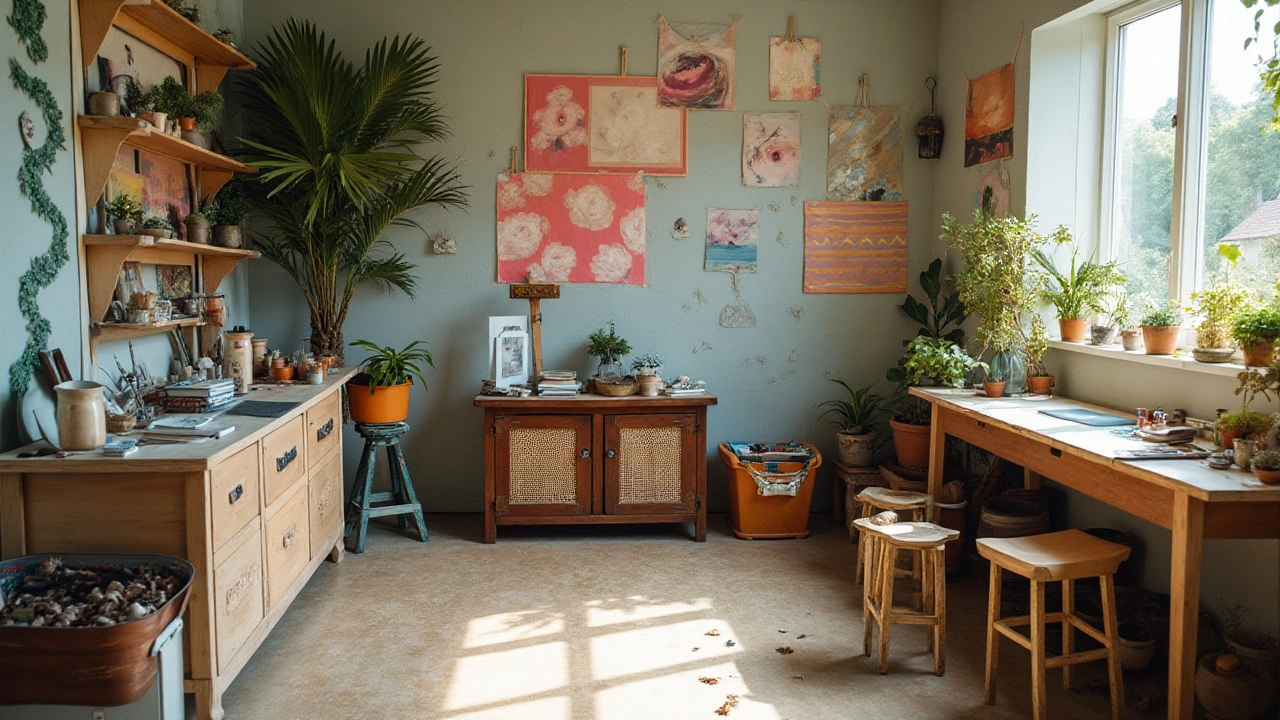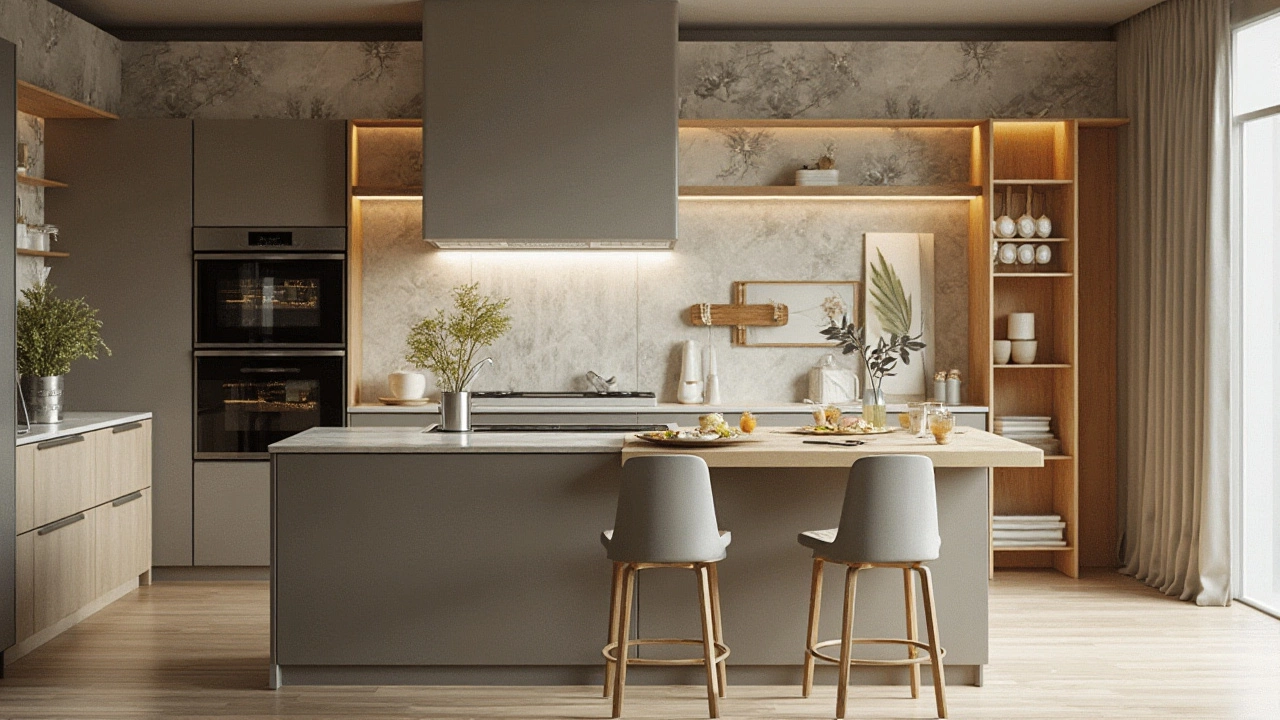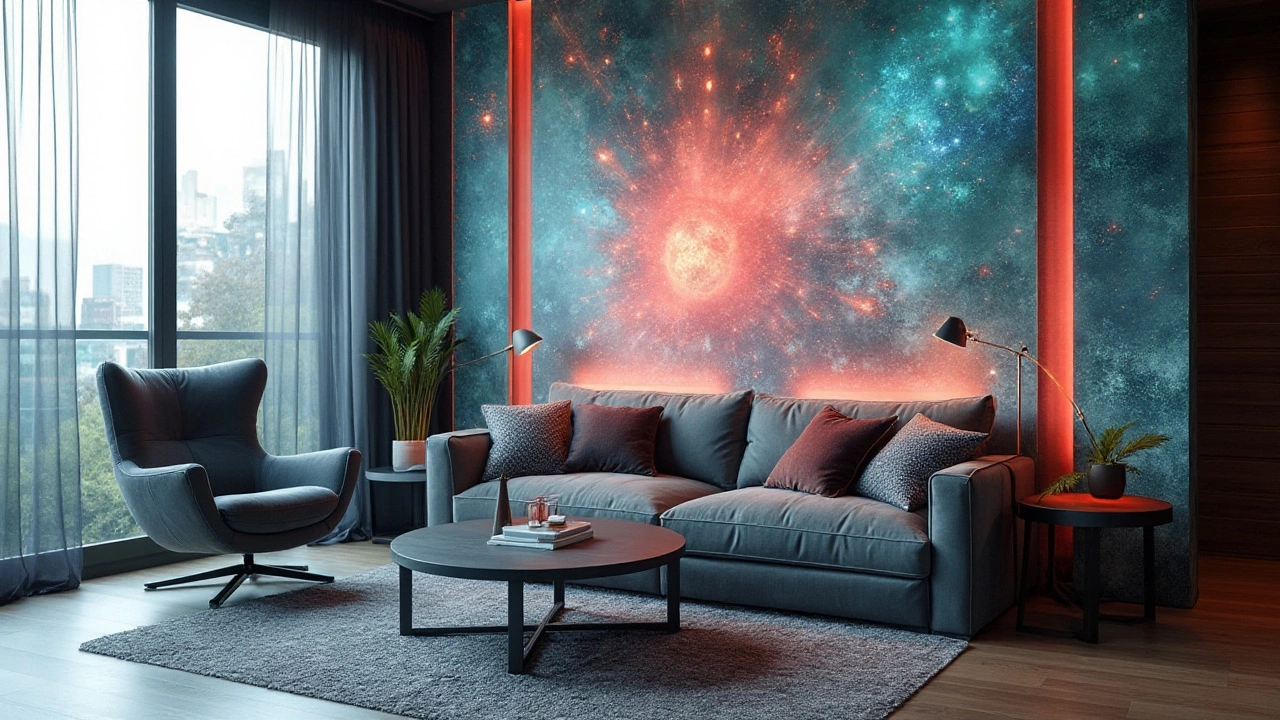As we lean into the horizon of 2030, interior design aficionados and homeowners alike are buzzing with curiosity about what the future holds for wallpaper styles. The next chapter in wallpaper trends promises to be an exciting blend of modern technology and time-honored craftsmanship. It's a stage set for innovation where tech-savvy designs meet artistic storytelling, providing immense possibilities for those looking to refresh their walls.
Expect to see wallpapers that are not just visual backdrops but interactive elements of your space, influenced by the rapid advancements in technology. Sustainability also takes center stage, with a growing demand for eco-friendly materials that do not compromise on style. Personalization will reign, as individuals seek unique, bold designs that echo their personal creativity and cultural influences. All these factors will come together to create wallpaper trends that redefine our spaces, making them more engaging and reflective of who we are in a rapidly changing world.
- Technological Influence on Wallpaper Designs
- Sustainability and Eco-Friendly Materials
- Vibrant and Personalized Aesthetics
- Interactive and Dynamic Wallpapers
- Cultural and Artistic Inspirations
Technological Influence on Wallpaper Designs
The world of interior design is experiencing a technological revolution, and wallpaper designs are not left behind. As we step into 2030, wallpapers are morphing from simple, static patterns into dynamic and interactive elements, thanks to the integration of cutting-edge technology. One of the most exciting advancements is the development of augmented reality (AR) wallpapers. These innovative designs allow users to change the appearance of their walls with just a few taps on a device, bringing a new level of personalization to home decor. Imagine scanning your wall with a smartphone and watching it transform into a picturesque scene or displaying a digital art gallery.
We also see a rise in the use of smart materials that adapt to different environments. Thermochromic inks, for example, can react to temperature changes, altering the color or revealing hidden designs depending on the room's warmth. This technology provides an enchanting element, allowing homes to change their ambiance throughout the day or night. Additionally, e-ink technology, known primarily for its application in e-readers, is finding its way into wallpaper trends, offering low power-consuming digital displays that can project varying patterns or vital information onto the walls.
Light is another aspect being incorporated into modern wallpapers. With the integration of LED technology, wallpapers are no longer limited to visual appeal but are becoming functional pieces of decor, providing ambient lighting to spaces. Smart wallpapers can adjust their brightness and hue to match the mood or time of day, creating a seamless blend of style and functionality. These technological advances not only enhance aesthetic appeal but also contribute to energy efficiency by reducing the need for additional light fixtures.
"The integration of technology into home decor signifies a transformative period in design," notes Jane Cleaver, a renowned interior design expert. "Wallpapers that change and adapt introduce a new dimension of interaction between homeowners and their living spaces."
Interactive and dynamic wallpapers are yet another marvel. With touch-sensitive designs and the incorporation of sensors, today’s wallpapers push the boundaries of classical methods. This innovation allows walls to respond to physical contact, perhaps to illuminate certain areas or control other smart devices within the home. Such advancements invite homeowners to experience their environments in an immersive and tactile way.
In 2030, the influence of technology on wallpaper design will undoubtedly redefine our expectations of home decor. It demands that we envision a space where walls are not just barriers but portals to creativity and personalization. As these trends continue to evolve, they provide exciting opportunities for artistry and innovation, aligning with modern needs and preferences. This fusion of technology and design invites us all to redesign our living spaces with possibilities as unlimited as our imagination.
Sustainability and Eco-Friendly Materials
The design landscape is undergoing a green revolution. As we get closer to 2030, the push for sustainability has penetrated deep into the veins of home decor, making a significant impact on wallpaper trends. It's fascinating how consumers' growing love for all things eco-friendly is reshaping the future of interior design. Transforming old standards, designers are now creating wallpapers made from recycled materials and using environmentally safe processes. These eco-friendly options aren't just trendy they are essential, reflecting our increased awareness and responsibility towards the environment.
A common choice among designers is to use natural fibers such as bamboo, jute, and cork, each offering a tactile texture that adds depth to spaces. Using these fibers, wallpapers prove there’s no need to sacrifice style for sustainability. This trend reflects a broader cultural shift towards individualized expression packaged in an environmentally conscious manner, a sentiment echoed by many.
Greta Thunberg, a prominent environmental activist, once said, "The greatest threat to our planet is the belief that someone else will save it." This reminder is guiding designers to infuse sustainability in every inch of their creations.
Noteworthy are technological advances that allow the creation of low or zero-VOC (volatile organic compound) wallpapers. Traditional wallpapers often emitted harmful chemicals. However, eco-conscious brands are pioneering production paths that prioritize health, avoiding toxic off-gassing. Digital printing is another rising star in this eco-revolution, offering precision without the pollution. It allows bespoke designs to be created on-demand, reducing unnecessary waste.
Looking ahead, advances in technology are likely to fuel even more innovations in sustainable wallpapers. For instance, biodegradable wallpapers infused with seeds are gaining attention. Imagine a future where a change in decor could also mean a new garden in your home. This isn’t a dream, but a forthcoming reality within sustainable design spaces.
The popularity of plant-based dyes in wallpaper production is a trend to watch. Derived from sources like spinach, turmeric, and beetroot, these colors provide a vivid palette without harming the environment. This choice not only supports biodiversity but also allows consumers to bring a touch of the natural world indoors.
It's an exhilarating time to witness such a dynamic, responsible transformation in home decor. As sustainability continues to blend with innovation, the 2030 landscape of wallpaper trends will undoubtedly reflect an era where aesthetic quality and eco-ethics flourish together harmoniously.

Vibrant and Personalized Aesthetics
The dawn of 2030 shines a light on a captivating trend in wallpaper trends: a deep dive into vibrant and personalized aesthetics. This shift signifies more than just an evolution in color palettes or patterns; it marks a revolutionary change in how people express their unique identity within their homes. As we observe, there is an increasing demand for interiors that echo personal stories and embrace vivid hues, bold prints, and culturally diverse elements. This desire to infuse homes with individual charm catalyzes a reimagining of traditional wallpaper designs. In effect, it transforms them into powerful canvases where imagination takes center stage, and self-expression knows no bounds.
Historical influences mingle effortlessly with modern inspirations. Designers are drawing from a vast pool of global cultures, resulting in rich tapestries of color and design influenced by the entirety of the world's artistic heritage. Take for example the resurgence of abstract art patterns and the use of motifs inspired by indigenous arts. These patterns embolden visual impact and invite an emotional connection to the walls they decorate. It creates a space that does not just house belongings but tells a story.
"Design is not just what it looks like and feels like. Design is how it works." – Steve Jobs
The influence of personalization isn't confined merely to aesthetics. It extends to a plethora of customizable options now available in wallpaper production. With advanced printing technology, consumers can choose personalized graphics, colours, and even fabrics that suit their vision perfectly. Think walls adorned with your favourite family photos or digital art commissioned exclusively for your personal gallery. The ability to dream it is fast becoming the ability to do it, bringing tremendous creativity and satisfaction to homeowners looking to stamp their individuality on their sanctuary.
Another remarkable development is the incidence of augmented reality in selecting and presenting these vibrant wallpapers. Imagine using AR apps that help visualize exactly how a particular design or pattern will appear in your actual living space! This technology makes it easier for consumers to make informed decisions, reducing the likelihood of buyer's remorse and sparking joy in the decorating process. Coupled with this is the development of wallpapers that can change patterns or colors based on environmental factors like light, temperature, or even user mood. Thus, interior design becomes a lively, responsive experience.
As we delve into the personal aspect of this trend, it's crucial to recognize the impact of color psychology. Colors stir emotional responses, influencing mood, productivity, and even interpersonal interactions within a space. For instance, yellows and oranges can worm through, bringing warmth and excitement, while blues and greens might evoke tranquility and calm. Designers now expertly leverage these attributes, crafting environments tailored to actual human needs and desires. The future is alive with possibilities.
The emergence of this trend towards vibrant, personalized aesthetics in interior design represents a conscious shift in consumer mindset. Modern homeowners increasingly view their homes as extensions of their personalities, striving to create spaces that do not just shelter but inspire. By demanding walls that are as unique as the individuals they surround, the era of generic, one-size-fits-all interiors is fading, paving the way for bespoke, dynamic living environments that reflect the vivid spectrum of human experience.
Interactive and Dynamic Wallpapers
The metamorphosis of wallpaper trends by 2030 is set to revolutionize how we experience our living spaces. Contemporary advancements in technology are now allowing for an exciting fusion of art with digital innovation. Imagine a wallpaper not just sitting silently against your wall, but breathing life into the room, adapting to your mood, and responding to the environment. These dynamic wallpapers are turning what was once a static element into an interactive canvas. As more homes incorporate smart technology, the integration of sound and movement with stunning visuals seems both striking and inevitable.
Dynamic wallpapers could potentially use smart materials and electronics to change colors or designs at the press of a button or through voice commands. It creates a space that is as versatile and evolving as the homeowner’s tastes, a reflection of individual creativity and style. “Homes are fast becoming the intersection between digital experiences and physical comfort,” suggests Katie Thompson, a renowned interior designer known for her futuristic designs.
"The most exciting element is that a wallpaper can set the tone for any occasion—be it a bright, floral in spring or a cozy, warm design in winter—allowing your walls to echo the world outside or the atmosphere within,"she adds.
These wallpapers not only enhance aesthetic appeal but also serve practical purposes. With embedded LED lights, they can provide ambient lighting suited to the time of day or activity, seamlessly blending style with function. Beyond mere decoration, these innovations are about enriching daily life through engaging experiences that stimulate the senses. The advancement doesn’t end here; smart wallpapers might also integrate biometric technology, adjusting with the pulse and mood of individuals present, aligning with emotions, thus creating an immersive home experience.
Let’s not forget the potential of augmented reality (AR). Imagine putting on AR glasses and watching as your home decor transforms into an educational display, scenic landscape, or even interactive storytelling for children. This reflects a step forward for both educational and entertainment purposes, making interior design an active participant in everyday life. In the coming years, homes could become multimedia environments where learning, playing, and relaxing are effortlessly embedded into family routines.
The market for such innovations will likely see a rise, leading tech companies to further refine and develop these interactive solutions. Current trends indicate an increasing demand for customization and the ability to adapt products to fit the consumer’s personal style. With this shift, the role of interior design transitions from mere spatial planning to creating thoughtful, interactive environments that enhance well-being.
As we move towards 2030, these interactive and dynamic wallpapers are poised not just as a decorative preference, but as a lifestyle choice ushering us into a realm where traditional design and cutting-edge technology coexist harmoniously. This inevitable trend signals a future where interior design and technology intertwine, marking a transformative period for how we adorn the spaces we call home.

Cultural and Artistic Inspirations
In a world growing increasingly interconnected, cultural and artistic inspirations are bound to play a pivotal role in shaping the wallpaper trends of 2030. Our living spaces have become canvases, reflecting the rich tapestry of global influences. Artists and designers are weaving diverse cultural motifs and traditional patterns into their modern creations, celebrating both the uniqueness and common bonds across societies. From the intricate geometric designs of Moroccan art to the minimalist elegance found in Japanese aesthetics, influences are as varied as the globe is vast. These elements, when applied to home decor, transform mere walls into stories of cultures and histories.
The digital age is blurring boundaries, making it possible for obscure cultural art forms to find a home in the most unexpected places. This has led to a resurgence in interest for artisanal techniques such as block printing and hand-painting, marrying age-old methods with contemporary twists. Designers today are not just creating, they are curating experiences that evoke a sense of place and emotion. It's about embedding cultural narratives into everyday environments, ensuring every corner tells a story. According to Victoria Westbrooke, a renowned interior designer, "When you bring elements of art and culture into your design, you are connecting people to something bigger than themselves."
Moreover, as the world grapples with the importance of sustainability, there is a renewed appreciation for craftsmanship that respects and preserves cultural heritage. This shift is prompting designers to source local, sustainable materials that highlight the beauty in imperfections and the authenticity of human touch. It's a move away from mass production towards more bespoke, meaningful pieces that honor both the planet and its diverse cultures. For example, designers are increasingly incorporating traditional weaving methods from South America or African mud cloth patterns, both of which add depth and texture to modern interior design.
Statistics show that decor pieces influenced by cultural art forms have seen a 25% increase in demand over the past five years. This trend is reflective of an evolving consumer mindset, one that values individuality, storytelling, and cultural appreciation. As people seek to differentiate themselves, they are turning their homes into personal museums of cherished memories and aspirational dreams. Whether it's a wall that reflects a cherished travel memory or a mural representing a long-held artistic admiration, these choices speak volumes about a person's journey and aspirations.
Looking ahead, as gears of commerce and culture turn together, we can expect to see more collaborations between artists and major wallpaper houses. These collaborations could result in limited edition pieces that fuse traditional artistry with modern sensibilities. The future is bright for those looking to experiment with cultural elements, creating immersive environments rich in character and creativity. As more designers and homeowners embrace this trend, wallpaper becomes not just decoration, but an essential medium for cultural expression and artistic dialogue.
